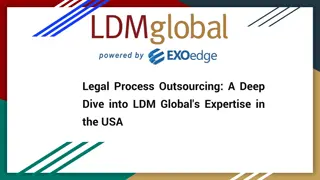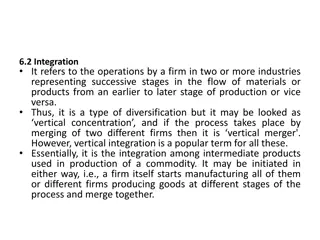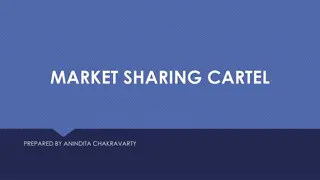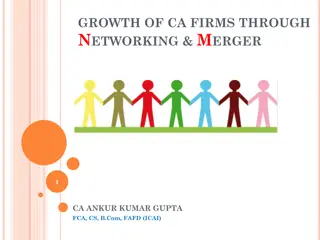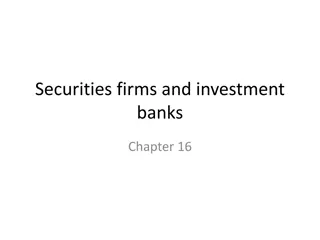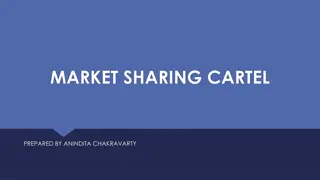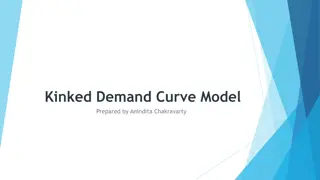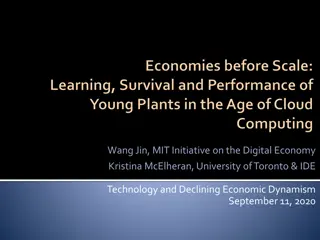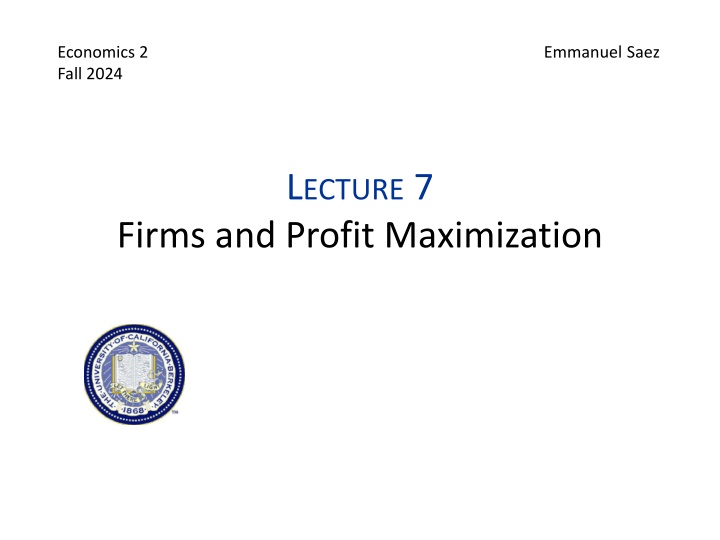
Firm Decisions in Profit Maximization and Perfect Competition
Explore the decisions firms make for profit maximization, including short-run and long-run choices of output and input mix. Learn about economic profits, opportunity costs, and perfect competition in industries with many small firms.
Download Presentation

Please find below an Image/Link to download the presentation.
The content on the website is provided AS IS for your information and personal use only. It may not be sold, licensed, or shared on other websites without obtaining consent from the author. If you encounter any issues during the download, it is possible that the publisher has removed the file from their server.
You are allowed to download the files provided on this website for personal or commercial use, subject to the condition that they are used lawfully. All files are the property of their respective owners.
The content on the website is provided AS IS for your information and personal use only. It may not be sold, licensed, or shared on other websites without obtaining consent from the author.
E N D
Presentation Transcript
Economics 2 Emmanuel Saez Fall 2024 LECTURE 7 Firms and Profit Maximization
Three Decisions a Firm Has to Make Short-run choice of output: How much to produce today with the existing set-up? Long-run choice of output: Expand or contract? Exit the industry? Enter the industry? Both short-run and long-run the choice of input mix: What combination of inputs (labor, capital, raw materials, and so on) to use to produce the output?
Profit Maximization We assume that firms objective is to maximize their economic profits. In reality, firms can also care about their workers, customers, communities The definition of economic profits: Profits = Total Revenue Total Costs, where: Total Revenue = Price * Quantity Sold Total Cost = Opportunity Cost of All Inputs
What Is the Opportunity Cost to a Firm of: Raw materials the firm buys? It s just what the firm pays. Unpaid labor the owner of the firm provides? It s what the owner could have earned in their next best alternative job. Money the owner puts into the firm? It s what the money what would earn in the next best alternative investment.
Quiz: Question: Consider a family running a restaurant and owning the place where it operates. As a result, they don t pay rent, only property taxes. What s the opportunity cost of using the place for the restaurant? A. Zero, because they don t pay rent B. Only the property taxes C. The money they could get if they rented out the place to another business. D. None of A, B, C
Perfect Competition Each firm is sufficiently small that its behavior has no impact on the prevailing market price. Occurs in industries with many firms, each of which is small relative to the overall size of the market. Small firms tend to predominate in industries where: Output is fairly similar across firms. It s easy for new firms to enter.
Why Do We Start with the Case of Perfect Competition? It s relatively simple It s an important reference point for economists (markets work well with perfect competition) We will study firms with market power later
Market and Individual-Firm Demand Curves Market Individual Firm P P S P1 D q Q The demand curve facing a perfectly competitive firm is perfectly elastic at the prevailing market price.
The Marginal Revenue Curve of a Perfectly Competitive Firm mr (in $) q
The Marginal Revenue Curve of a Perfectly Competitive Firm mr (in $) mr P1 Marginal revenue for a perfectly competitive firm is constant and equal to the prevailing market price. q
Marginal Revenue: The Additional Revenue Associated with Producing One More Unit mr (in $) P1 q q1+1 q1 Total revenue at q1: The rectangle with width q1 and height P1. Total revenue at q1+1: The rectangle with width q1+1 and height P1. Marginal revenue at q1: The rectangle with width 1 and height P1.
Different Types of Costs Fixed costs: Costs that do not depend on how much is produced: Cf (drilling the oil well) Variable costs: Costs that do vary with how much is produced: Cv(q) (pumping quantity q of oil out) Total costs: The sum of fixed and variable costs: C(q)= Cf+Cv(q) Marginal cost: The change in total costs from producing one more unit: mc=C (q)= C v(q) Note: Since fixed costs do not change when one more unit is produced, marginal cost is also equal to the change in variable costs from producing one more unit.
Marginal Cost: The Additional Cost Associated with Producing One More Unit mc (in $) q
Marginal Cost: The Additional Cost Associated with Producing One More Unit mc (in $) q First there are economies of scale in production as it s less costly (per unit) to produce in bulk
Marginal Cost: The Additional Cost Associated with Producing One More Unit mc (in $) q Second, there are diseconomies of scale in production due to constraints (for example only 1 factory)
Marginal Cost: The Additional Cost Associated with Producing One More Unit mc (in $) mc q We assume upward mc because competitive model does not work well with declining mc (leads to monopoly)
The Profit-Maximizing Level of Output for a Perfectly Competitive Firm P mc P1 mr q q1
Marginal profit is marginal revenue minus marginal cost P Marginal profit of 1st unit produced and sold mc P1 mr q 1 q1
Marginal profit is marginal revenue minus marginal cost P Marginal profit of 2nd unit produced and sold mc P1 mr q 1 2 q1
Competitive firm produces up to point where mc=mr P Total marginal profit of producing q1 mc P1 mr q q1
Mathematical maximization Consider a smooth function q L(q) If L(q) is maximized at q* (interior) then: L (q*)=0 (slope is zero at the top of the smooth hill): this is called the FIRST ORDER CONDITION L (q) 0 for q just below q* and L (q) 0 for q just below q*: this is the SECOND ORDER CONDITION First and second order conditions are necessary at interior maximum but not always sufficient
Mathematical maximization L(q) L(q) q q*
Mathematical maximization L (q*)=0 L (q) 0 L(q) L (q) 0 L(q) q q* Slope is flat at top of the hill (L (q*)=0), uphill below q* (L (q) 0) and downhill below q* (L (q) 0)
Condition for Profit-Maximization Marginal Revenue = Marginal Cost (mr = mc) For a perfectly competitive firm, this is same as: Price = Marginal Cost (P = mc). Mathematically: choose q to maximize P q-C(q) where C(q) is total cost of producing quantity q Function is maximized when derivative with respect to q is zero (taking P as fixed parameter) Implies P-C (q)=0, which is P=C (q)=mc
Entry decision of competitive firm: Compare total marginal profits and fixed costs P Total marginal profit of producing q1 mc P1 mr q q1 If green area exceeds the fixed cost of production Cf then the firm enters and produces q1.
Quiz 1: Question: Consider an existing oil drill in North Dakota with marginal cost of producing 1 barrel of oil at $50. Suppose, price of oil falls permanently from $80 to $60. What should the business do? A. Keep pumping oil out B. Keep pumping oil only if this can recoup the fixed cost C. Stop pumping oil. D. A, B, C could be true, it depends on parameters
Quiz 2: Question: Consider an oil drill project in North Dakota with marginal cost of producing 1 barrel of oil at $50. Suppose the price of oil is expected to be $60. Should the project go ahead? A. Yes B. Yes if fixed costs are small enough C. Yes if fixed costs are large enough D. No E. Either A, B, C, D could be true, it depends.
Impact of a Rise in the Market Price P mc P1 mr1 q1 q
Impact of a Rise in the Market Price P mc mr2 P2 P1 mr1 q2 q1 q
A Firms Supply Curve P s ,mc P1 q1 q It shows the quantity the firm supplies as a function of price. It also shows the price it takes to get the firm to supply a given quantity. Since that price is the firm s marginal cost at that quantity, this means that the firm s supply curve is also its marginal cost curve.
Two Ways of Thinking about an Individual Firm s Supply Curve The quantity supplied by the firm as a function of the market price ( horizontal interpretation). The firm s marginal cost as a function of the quantity it produces ( vertical interpretation).
Market and Individual-Firm Supply Curves Market Individual Firm P P q Q
Market and Individual-Firm Supply Curves Market Individual Firm P P S (also s) (also MC) s (also mc) q Q The market supply curve is also the marginal cost curve for the whole industry.
Two Ways of Thinking about the Market Supply Curve The horizontal sum of individual firms supply curves. The industry s marginal cost curve.
The Industry Supply Curve Is the Industry Marginal Cost Curve Example Suppose there are 100 firms. Each has MC at 1000 units of $5, MC at 2000 units of $6, etc. $ 7 $ 7 6 5 6 5 mci (also si) 4 4 3 3 2 2 1 1 0 0 q Q 100K 200K 300K 2K 3K 0 0 1K
The Industry Supply Curve Is the Industry Marginal Cost Curve Example Suppose there are 100 firms. Each has marginal cost at 1000 units of $5, marginal cost at 2000 units of $6, etc. Then the marginal cost of the industry at 100,000 units is $5, at 200,000 units is $6, etc. $ 7 $ 7 6 5 6 5 MC (also S) mci (also si) 4 4 3 3 2 2 1 1 0 0 q Q 100K 200K 300K 2K 3K 0 0 1K
An Improved Production Technology Market Individual Firm mc1 P P S1 q Q
An Improved Production Technology Market Individual Firm mc1 P P S1 mc2 S2 q Q
An Increase in the Price of an Input Market Individual Firm P P mc1 S1 q Q
An Increase in the Price of an Input Market Individual Firm mc2 P P S2 mc1 S1 q Q
Entry of a Large Number of New Firms Market Individual Firm P P mc1 S1 q Q
Entry of a Large Number of New Firms Market Individual Firm P P mc1 S1 S2 q Q
Other Possible Reasons the Market Supply Curve Could Shift Taxes. Government regulations. Would a change in the price of the good shift the supply curve? No it would cause a movement along the supply curve. Try to think of more possibilities!
Quiz: Question: Suppose the world price of oil increases due to developments outside the US (e.g. oil embargo on Russia). How does this shift the supply curve of US produced oil? A. The supply curve goes up B. The supply curve does not change C. The supply curve goes down D. Either A, B, C could be true, it depends.







